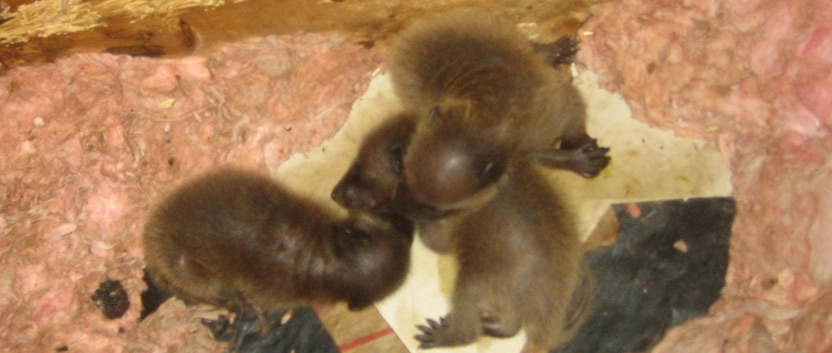NEED LOCAL HELP? We have
wildlife removal professionals servicing 95% of the USA. Click
here to hire a
local raccoon removal expert in your home town. Updated
2018. But read the below advice first!
There are a couple of indicators that can let you know if you
have baby raccoons in your attic.

Visual sightings. If you see an adult raccoon going in and out
of your attic, it’s more than probably a female raccoon that is
either preparing to have a litter or nursing a litter in a nest
she made there. The female raccoon will emerge from the attic
after dusk to go forage for food, and she will return sometime
during the night. You could be dealing with a male raccoon, as
they look for shelter in more northern areas during wintertime,
and may set shop in your attic. But if it’s springtime, the
chances of it being a male and not a female are very small.
Also, in southern areas, female raccoons are known to breed
throughout the year, not only in spring.
Protruding nipples. If you trap a female raccoon that’s been
living in your attic, or are able to see her from up-close, a
clear sign of babies is if you can detect the raccoon’s nipples.
If her nipples are sticking out, surely there’s also a litter up
there.
Scratching. Most attic pest scratch and thump, and as the
raccoon is the largest of the animals that den in our attics,
you can easily distinguish their rather heavy scratching and
thumping from the noises smaller animals such as squirrels or
rats make. Again, if you have a raccoon in your attic, it’s most
likely a female with babies. So if you hear raccoon scratching,
you can safely assume that there’s a litter in there.
Vocal sounds. Baby raccoons make a distinctive chitter sound.
The sound baby raccoons make is pretty complex, a combination of
vibrations, screeches, warbles, and chitters. And it’s very much
their own particular sound, very different from the one baby
squirrels or other animals make. Their cry and twittering sound
is one of the best baby raccoon identifiers, other than direct
visual contact.
Originally, raccoons denned in hollow trees, as far up from the
ground as they could get. Perfectly adapting to our modern
structures, raccoons started emulating their natural conditions
by nursing and raising their litter up in chimneys and attics.
Our attics provide them with all the perfect conditions, even
relieving them of duties such as creating a nest with branches
and twigs, as the attic insulation will do just fine. And while
cold winters are a factor that will also bring male raccoons
into our attics, the female raccoon population is the one that
usually ends up in our attics. So, if you have a raccoon in your
attic, you might as well just expect it to be a female with
young, and treat the problem accordingly.
Go back to the Raccoons in the attic
home page.
Read more articles about Raccoons:
Should I Hire a Pro, or Remove Raccoons Myself?
Do Female Raccoons Make Good Mothers?